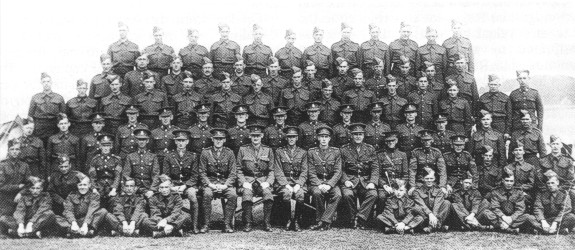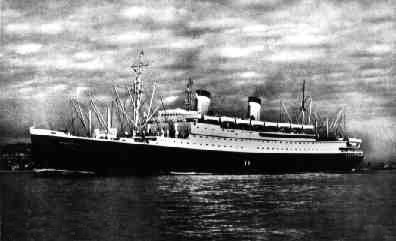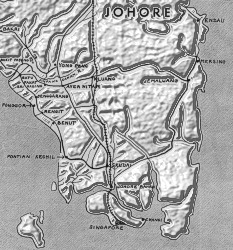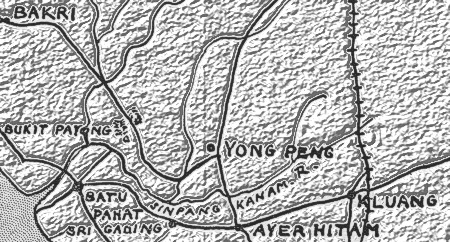|

Please click on the above photo to enlarge
“A” Company at Summer Camp 1939
September 1st 1939 in Norwich saw the battalion mobilised with 24 officers, 27 warrant officers aand sergeants, and 483 other ranks. Lt.-Col. D.C.Buxton was in command and Maj. H.S.Ling MC was second in command. The battalion was organised into three rifle companies at the outbreak of war with a further “D” company being formed on November 30th when the battalion reached a strength of 785 in all ranks. At the end of 1939 they were moved to Sheringham and were billeted in the town. They were then brigaded with the 5th Battalion Royal Norfolks and the 2nd Cambridgeshires to form the 53 Infantry Brigade which was part of the 18 Division.
During the bad winter of early 1940 the brigade helped the Norfolk County Council with snow clearing in the area, it was very cold work with high drifts of snow. The bad weather made out door training difficult and there was not many halls big enough for them, their training suffered. The dining room of the Sheringham Hotel came to the rescue and helped the men train in the warmer conditions. The main training was the handling of rifles, bren gun and anti-tank rifle.
When the weather improved, training begun outside in ernist, with route marches up to 15 miles, but equipment was still short with only six bren guns and one 2 inch mortar within the battalion.
As the spring came night patrols were performed and the Sheringham golf course became their traing ground with a rifle range in Upper Sheringham. With the invasions of Belguim, Holland and Luxemburg the battalion was given the task of guarding West Raynham aerodrome and Cromer Pier. The battalion manned the coast from Overstrand to Sheringham in four places Overstrand, Cromer, East and West Runton, and Sheringham.
When a roundsman reported seeing parachutists at Felbrigg on May 14th, a platoon from “D” company was sent out to search the area. Thay had no luck in their search and when cross examined again it was found the roundsman was lying.
On May 22nd, Lt.-Col. Buxton was relieved in command by Lt.-Col. F.L.Cubitt. Further coastal defences were laid. With the invasion threat now over in July and although still manning the coastal defences, serious training begun with larger scaled excercises with the 5th battalion.In August they were relieved of their coastal duties by the 2nd Cambridgeshires and moved to the Gresham School at Holt for a month of training. During this period Lt.-Col. J.F.Ross took over command and Maj. F.M.E.D.Drake was put as second-in-command from the 1st Battalion.
The 6th Battalion relived the 5th Battalion at Weybourne on September 21st, training continued till October when the battalion was relieved by the 9 Lincolns, this took the whole of the 18 Division into reserve with quaters at Swaffham in Houses and farms.
In January 1941 a move to Scotland for the 18th Division saw more advanced training, the 6th Battalion being entrained for Dumfries. The day before their departure a German bomber dropped its bombs on the Swaffham Railway station, causing the death of six privates who were loading the train.
February saw the Scottish weather prove hostile with snow on most days, training continued in the companies and it wasn´t till the weather improved during March that battalion, Brigade and Divisional excercises could take place. The hills helped develope the men physically, and by the beginning of April 1941 the battalion looked in shape.
A move to Hartford saw more specialised training with large scale excercises and assualt crossings of the Rivers Weaver, Teme and Severn. Each rifle company was pu through a three day march covering 60 miles which finished with a night attack.
Lt.-Col. I.C.G.Lywood took over command on July 15th and in August the division was moved to Lancaster with the battalion being accommodated at Knowsley Park. They were put under canvas untill wooden buildings were errected. An attack on Carlisle was carried out at the end of the month, testing its defences. A further attack, this time on Otley in Yorkshire, was carried out at the beginning of September.
|

|
|
USS Mount Vernon - 26,000tons
|
|
The battalion, division and brigade were then given news that they were ready for posting abroad and on October 27th the battaion embarked from Gourock on the Duchess of Atholl for Halifax. At Halifax the whole of the 53 Brigade was transhipped to the Mount Vernon. After a brief visit to Trinidad to refuel, Cape Town was reached on December 9th. Shore leave was granted before sailing on the 13th December for Bombay only to be then ordered on the 23rd to sail for Mombassa and then finally Singapore. She was escorted by the H.M.S. Emerald and reached Singapore Harbour on January 13th 1942, the battalion disembarked in heavy rain and moved to Tyersall Park Camp by truck.
Preparations for moving the troops from the Tyersall Camp to Malaya, were made on the 14th January. Four experienced F.M.S.V.F. officers were attached for communication with the Malays as interpreters and interrogators.
No training was given before they were dispatched and the hope they were to receive any in Malaya was quickly demised as they were put straight into the battle for Malaya.
Johore - Malaya
|

|
|
Johore - Malaya
|
|
Detail from Royal Norfolk Regiment
|
|
|

|
|
Jahore
|
|
Detail from Royal Norfolk Regiment
|
|
On January 16th Advance Battalion H.Q. were moved along with “C” and “D” companies by transports to Yong Peng, on the following day Maj. A.B.Cubitt and the rest of the battalion joined them.
Moving west from Yong Peng “C” and “D” companies took up defensive positions along the Bakri Road at the defile marked on the map. “A” and “B” companies were moved in just to the rear to support. The battalions task was to cover the lines of communication with the 45 Infantry Brigade who were under heavy attack near Muar.
The 19th January was spent patrolling the road and the Simpang-Kanan River although they made no contact with the enemy, the Australian “B” Echelon transport passed through the battalion lines and was attacked six miles north.
On the 20th a patrol suffered casualties when attacked near the river, then later a full attack took place. The Japanese attacked from the forward positions and also having infiltrated got behind “C” and “D” companies and attacked them from the rear, cutting off help from “A” or “B” companies.
“D” company held out and stayed together but “C” company having been out on patrol during the attack were separated and lost contact. During the attack “D” company lost their commander Capt. P.M.Westagate. “C” company had their commander, Capt.H.P.Pilkington wounded and 2nd/Lt. J.E.Parker was killed. Fighting carried on during the night but with the Japanese in control of the south of the defile “D” company was in a dire position. Early the next morning the 3/16 Punjabis and then “B” company tried in vain to force out the enemy, both attacks failed. With “D” company still cut off the defile was given up and a new line of defence further south was set up.
On the 22nd January the 2nd Loyals got into a position to attack the defile but with no artillery fire it was called off. In the afternoon the battalion which now consisted of less then two companies were ordered to withdraw to Yong Peng. “B” company fought bravely in in a rearguard action for the brigade and they reached Yong Peng late that evening.
Command of the battalion was taken over by Major A.B.Cubitt when Lt-Col. Lywood was evacuated to Singapore with illness.
On the 23rd the battalion was moved to Skudai, just south of Ayer Hitam. Early on the 24th the battalion moved up again to Benut on the coastal road, where it was reorganised as Battalion H.Q. and “A” and “B” companies, their support was by the 4.5 Howitzers and one section of Royal Engineers. There orders were to keep the road open for the 5th Norfolks and 2nd Cambridgeshires, this also included a mixture from the Leicestershire and East Surrey Regiments. “A” company supported at Rengit whilst the remainder moved forward to Seggarang, eight miles south of Batu Pahat. Although no enemy were reported in the area the rear of the force came under heavy machine-gun fire and suffered casualties, snipers did not help their situation neither.
Having taken control of Senggarang, they could not cover their rear and the enemy infiltrated and set up road blocks behind them. cutting them off from “A” company. The 15 Brigade was then ordered to withdraw from Batu Pahat to help at Senggarang. Late on the 26th the Cambridgeshires were ordered to fight their way south and “A” company to attack from the south, to try to clear the road, both failed. The bridge at Senggarang was then blown and the 250 transport vehicles destroyed, the troops were ordered to find their way back through the jungle.
“A” company by this time had been surrounded by the Japanese at Rengit, they held off attack after attack until it was seen to be a hopeless situation, they then took to the jungle and two officers and 85 other ranks made their escape to Singapore.
Killed in the fighting for Senggarang were:
Capt. R.R.Evans
2nd/Lts R.O.C.King, R.H.Notts, A.E.Jones, M.C.Mitchell, J.A.Salter and E.L.Weymont
For his gallantry, initiative and disregard for his own safety 2nd/Lt Nutt was mentioned in dispatches.
After the withdrawal from Senggarang about 200 men made their way through the jungle to Ponggor on the coast, where they were taken off by Royal Navy gunboats to make a rather uncomfortable trip back to Singapore, they were then housed near the Seleltar River.
Singapore
|

|
|
North Singapore
|
|
Detail from Royal Norfolk Regiment
|
|
The 6th Battalion was reorganised and kept under command of 11 Indian Division and were responsible for defending the north side of the island and Singapore itself. The reorganised battalion was now in three, “D” being the company to be spread amongst the other three to bring them up to strength.
The coastal defences of that part of the island took over their nights as enemy shelling and bombing was a daylight activity to be missed. The enemy attacked the east of the island and thus this work in the end was worthless as a defence as after establishing a foothold the Japanese soon infiltrated west. The battalion crossed the Seltar River and withdrew to the Navel Base on the Singapore road, together with the 2nd Cambridgeshires and 2/19 Australian Battalion.
Attacking these positions on February 13th through the jungle the enemy soon infiltrated behind the allied positions. Capt J.Stratford was killed and Lt Garrett severely wounded, he later died of his wounds. On the 14th they withdrew to support the 5th Royal Norfolks at Braddell Road.
At 4pm that day Singapore capitulated, the killing did not stop then as Capt. P.Cambell Orde was killed when a bomb landed on the hospital and the C.O. Lt.-Col Lywood was among the Alexandra Hospital massacre.
Three and a half years of torment and hunger then followed where one in three died in the Japanese prisoner of war camps.
|